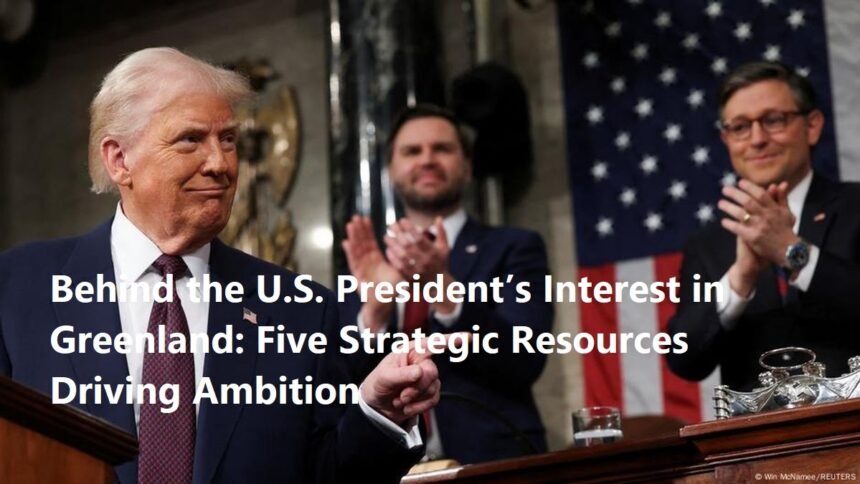The idea of the United States acquiring Greenland might sound like a relic of 19th-century imperialism, but in 2019, former President Donald Trump publicly floated the notion of purchasing the autonomous Danish territory. While the proposal was swiftly rejected by Denmark and Greenland’s government, it underscored a deeper geopolitical and economic reality: Greenland is a treasure trove of untapped natural resources. Beyond its vast ice sheets lies a land rich in oil, rare earth elements (REEs), titanium, rubies, and uranium—resources critical to modern technology, energy security, and military dominance. Here’s why these five assets make Greenland a focal point of American strategic interest.
- Oil: A Frozen Frontier for Energy Independence
Greenland’s icy waters are believed to hold up to 17.5 billion barrels of oil and 148 trillion cubic feet of natural gas, according to the U.S. Geological Survey. As Arctic ice retreats due to climate change, accessing these reserves becomes increasingly feasible. For the U.S., which still relies on oil imports for about 8% of its needs, controlling Greenland’s resources could bolster energy independence and counterbalance rivals like Russia, which is aggressively developing Arctic oil fields. However, exploration remains contentious. Greenland banned new oil drilling licenses in 2021 to prioritize climate goals, but shifting political winds—or external pressure—could reopen these opportunities.
- Rare Earth Elements: Breaking China’s Monopoly
Greenland’s bedrock contains some of the world’s largest deposits of rare earth elements (REEs), critical for manufacturing smartphones, electric vehicles, wind turbines, and advanced weapons systems. The Kvanefjeld (now renamed Kuannersuit) mine alone holds an estimated 1.5 million tons of REEs, alongside uranium. China currently dominates 70% of global REE production, giving it leverage in trade and defense sectors. By securing Greenland’s reserves, the U.S. could reduce its dependency on China and strengthen its tech and military supply chains. This aligns with broader U.S. efforts, like the Inflation Reduction Act, to reshore critical mineral processing.
- Titanium: Aerospace and Defense Applications
Greenland hosts significant titanium reserves, a metal prized for its strength, lightness, and corrosion resistance. Titanium is indispensable for aerospace engineering (jet engines, spacecraft) and military hardware (submarines, missiles). The U.S. imports over 70% of its titanium, largely from Russia and China—a vulnerability in an era of escalating great-power competition. Greenland’s deposits, particularly in the southern region, could provide a secure alternative. Companies like BlueJay Mining have already begun exploring Greenland’s titanium-rich sands, though large-scale extraction remains untapped.
- Rubies: Gemstones and Industrial Uses
Greenland is home to one of the world’s largest ruby deposits, discovered near the capital, Nuuk. These gems are not just luxuries; rubies (a form of corundum) are used in lasers, electronics, and precision instruments. While artisanal mining has occurred for decades, commercial operations are nascent. For the U.S., investing in Greenland’s gemstone sector could support high-tech industries while countering China’s control over global gem markets. Moreover, Greenlandic rubies are marketed as “ethical” alternatives to gems from conflict zones, appealing to Western consumers.
- Uranium: Fueling Nuclear Ambitions
Greenland’s uranium reserves, estimated at 570,000 tons, are intertwined with its rare earth deposits. Uranium is essential for nuclear energy and naval propulsion systems, such as those powering U.S. aircraft carriers and submarines. As the U.S. seeks to expand its nuclear capacity to meet climate goals, Greenland’s reserves could provide a long-term fuel source. However, uranium mining remains politically sensitive. Greenland lifted a decades-old ban on uranium extraction in 2013, but local opposition persists due to environmental and cultural concerns.
Geopolitical Chessboard: The Arctic’s Rising Importance
Beyond resources, Greenland’s geographic position in the Arctic is strategically vital. The U.S. maintains Thule Air Base in northern Greenland, a key node in North American missile defense. As melting ice opens new shipping routes like the Northern Sea Route, controlling Greenland would enhance U.S. influence over Arctic trade and military logistics. It would also counter Russia’s militarization of the region and China’s attempts to gain footholds through investments in Greenlandic infrastructure (e.g., airports, mines).
Obstacles to U.S. Ambitions
Despite Greenland’s potential, several barriers stand in the way:
- Local Resistance: Over 90% of Greenland’s population opposes U.S. ownership, fearing cultural erosion and environmental harm.
- Climate Advocacy: Greenland’s government prioritizes sustainable development, clashing with fossil fuel extraction.
- Denmark’s Role: While Greenland is self-governing, Denmark retains control over foreign and defense policy, complicating unilateral U.S. deals.
The U.S. interest in Greenland reflects a cold calculus: whoever controls the island’s resources and geography could dominate the 21st century’s energy and tech landscapes. Yet, Greenland is not a passive prize. Its people and government are determined to leverage their resources on their own terms, balancing economic gain with environmental stewardship. For now, the U.S. must navigate diplomacy, investment, and partnerships rather than outright acquisition. As the Arctic’s ice melts, Greenland’s strategic value—and the global race to secure it—will only intensify.












